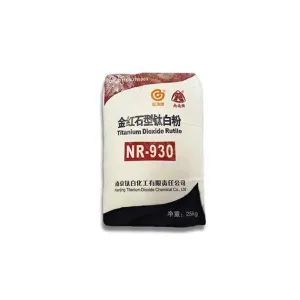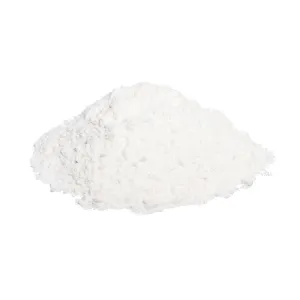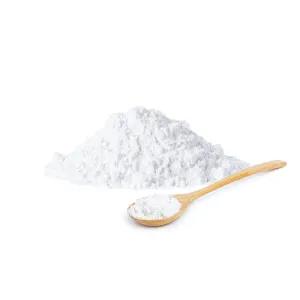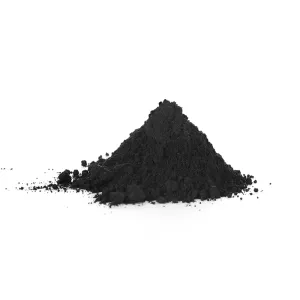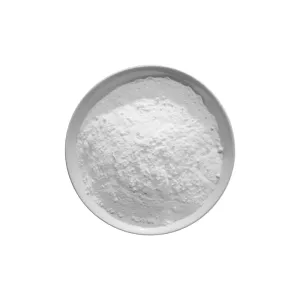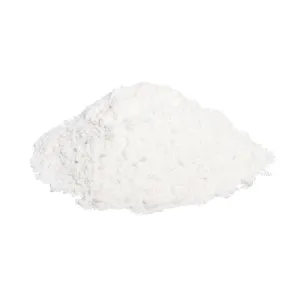Caustic soda: The chemical industry’s next global shortage…
Caustic soda demand could exceed global capacity in the latter half of this decade. That’s what analysis of trends versus current and future capability indicates, says Tecnon OrbiChem chlor-alkali market expert Hira Saeed.
The potential for shortfall will largely depend on the severity of the downturn in global economic activity predicted – and later outlined in more detail – by the International Monetary Fund.
The main problems within the chlor-alkali sector in 2022 revolve around the high price of caustic soda in Europe due to the natural gas and electricity price hikes. ‘In Q2, due to high export prices out of Europe, very few deals have been concluded but this has begun to improve lately as European exporters have reduced prices in order to be competitive,’ says Saeed. The continuance of high freight costs and delays are among the obstacles to successful export strategies.
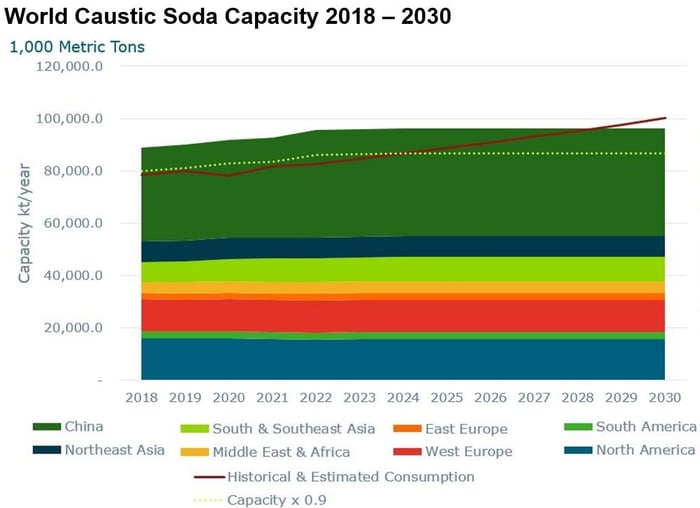
Source: Tecnon OrbiChem
The dotted yellow line in the graph above shows plants running at the 90% capacity we can expect, with the red line representing historical consumption and forecast to 2030. The graph demonstrates that if capacity remains at current levels with no new plants coming online, forecasted consumption will exceed capacity between 2024 and 2025.
Ebbs & flows
US caustic soda demand dropped around 5% in 2020. Most of the product’s downstream sectors were significantly affected by the pandemic except for the detergents, water treatment and bleach sectors. The packaging sector was boosted during the pandemic as consumers sought goods via online websites and those purchases required packaging solutions.
When the US economy began bouncing back in 2021, its 2.5% recovery rate was lower than expected, due to unforeseen circumstances including February’s Deep Freeze, which impacted demand – and predictions – for caustic soda. The sector’s recovery was slow and lingers still. Caustic soda supply remains short today, in part, because of 2021’s production cuts. Our blog post Deep Freeze: The aftermath includes a detailed analysis of the impact on production and trade flow.
Typically, a high proportion of West European imports come from the US but that decreased recently due to US production cuts, transportation costs and long lead times.
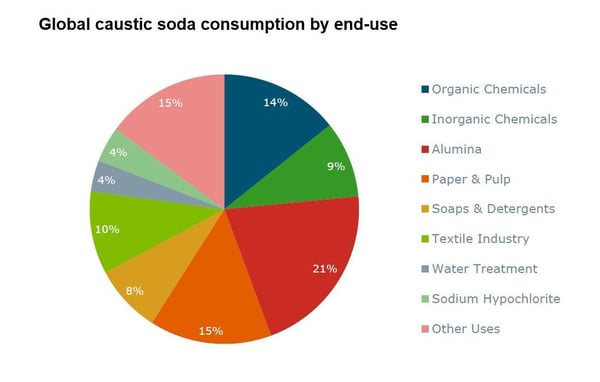
Source: Tecnon OrbiChem
Driving caustic soda demand
As the chart above shows, the chemical sector is major consumer caustic soda globally. Traditionally, alumina accounts for 21% of caustic soda consumption, however, it is one of the sectors that has struggled to recover from the pandemic and supply chain issues including the global semiconductor chip shortage. And just as the chip shortage has started to ease, a deteriorating economy is emerging. This will likely limit the automotive industry’s potential to bounce back in the foreseeable future.
North American and West European alumina sectors are relatively small in comparison to the commodity’s global consumption rates. Despite this, the aluminium sector is still important, especially for US export demand. For example, the US exports quite a lot of caustic soda to Australia, which is used in the aluminium sector.
Pulp & Paper
As explored by Tecnon OrbiChem’s sister company Fisher International Covid supercharged e-commerce and packaging: What’s next?, the pandemic triggered a paper boom as demand for tissue products soared, along with feedstock materials for facemasks and corrugated board for e-commerce packaging due to the explosion of online purchases by locked down consumers.
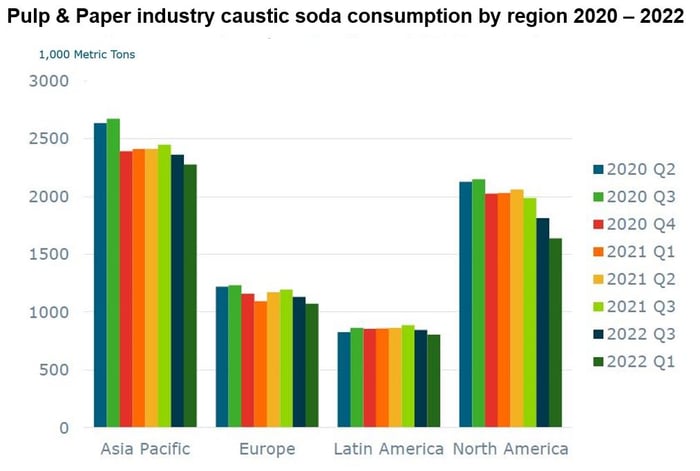
Source: Tecnon OrbiChem
Pulp & Paper in war
It is estimated that Russia’s consumption of caustic soda for Pulp & Paper industry purposes in 2021 was in excess of 120,000 metric tons. This usage was between companies including the Ilim Group, Sylvamo, Mondi Group, Karjala Pulp, Kama, Syassky and Solikamskbumprom. A graph showing each company’s estimated consumption is included in the downloadable presentation e-Book.
Since Putin’s invasion of Ukraine in February, Sylvamo announced plans to exit the Russian market and Mondi has highlighted operational constraints around imports of materials vital to its mills.
As a joint venture with the US-headquartered International Paper, Ilim’s future remains somewhat uncertain given the former’s commitment to exploring options for the 50/50 venture. Further shifts and adaptations are sure to follow in the coming months, especially off the back of EU’s ban on imports of wood and some paper products from Russia.
Calculating ECU
Because high electricity costs are having such a great impact on the cost of production of caustic soda, Tecnon OrbiChem consultant Hira Saeed calculated the costs based on three energy megawatt hour (MWh) scenarios between €55 and €275 per MWh. In the video and presentation, Saeed demonstrates how it is that electricity costs have become the majority of the cost of caustic soda production in Europe.
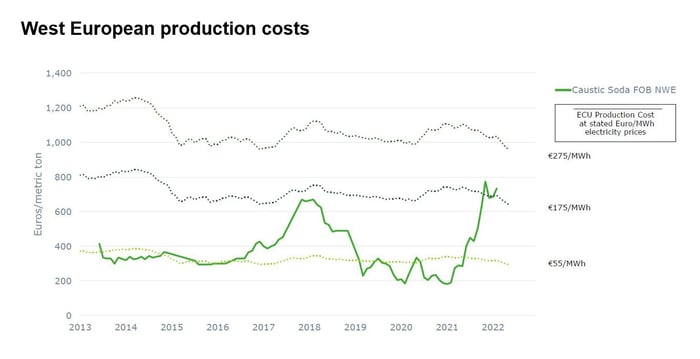
Source: Tecnon OrbiChem
The green line in the graph above represents the cost of export prices out of Europe, which have been soaring since 2021. They are higher than 2018 levels, when the phasing out of Mercury-based chlor-alkali production reduced European capacity
Looking forward, operating rates in Europe are likely to remain reduced due to weakening demand in some chlorine derivatives. The US is likely to see this too, but perhaps to a lesser degree due to capacity curtailment and ongoing production issues. However with hurricane season imminent, operating rates may be affected.
These circumstances will probably keep caustic soda balanced over the next couple of months. Q3 or Q4 may see some softening in demand or lengthening of caustic soda supply.
Caustic conclusion
Caustic soda lost around three years’ growth due to the pandemic and capacity currently online is going to be sufficient until around 2025. Without added capacity though, we could see shortages along with the price hikes that necessarily follow. But which companies will be willing to invest in new plants or expansions at such a volatile time?
This blog post is inspired by Tecnon OrbiChem consultant Saeed’s presentation in the video below. It was among Tecnon OrbiChem’s contribution to the Chlor-Alkali in 2022 webinar event held in June and co-organised with our partner ICIS.
To access Saeed’s full presentation, simply fill in the box below and you will receive an email with a link to the presentation e-Book.
Recommended Suppliers
 September 23, 2024
September 23, 2024  June 3, 2024
June 3, 2024  June 3, 2024
June 3, 2024  June 17, 2024
June 17, 2024  June 18, 2024
June 18, 2024 
